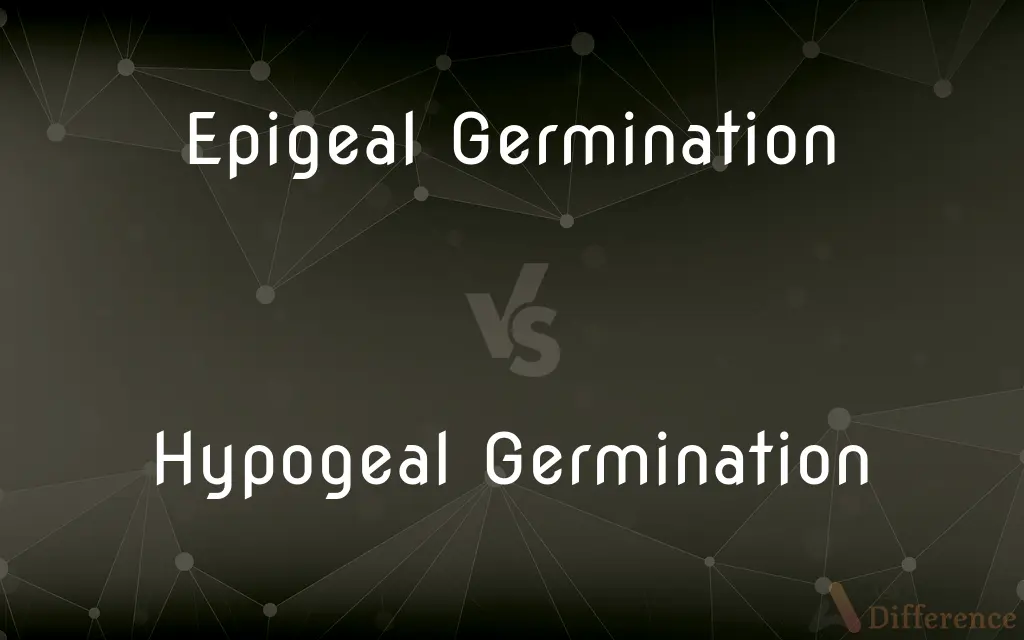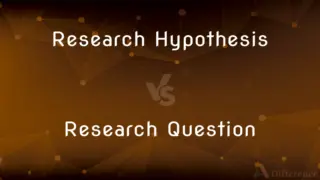Epigeal Germination vs. Hypogeal Germination — What's the Difference?
By Tayyaba Rehman — Published on December 25, 2023
In Epigeal Germination, cotyledons are raised above the soil, while in Hypogeal Germination, they remain below the soil surface.

Difference Between Epigeal Germination and Hypogeal Germination
Table of Contents
ADVERTISEMENT
Key Differences
Epigeal Germination refers to the process where the cotyledons (first leaves) of a germinating seed rise above the soil due to the elongation of the hypocotyl (stem of a germinating seed). Conversely, in Hypogeal Germination, the cotyledons stay beneath the soil surface as the epicotyl (part of the stem above the cotyledons) elongates and pushes the shoot above the ground.
In the case of Epigeal Germination, the process is easily observable as the cotyledons, being above the soil, are visible. This is common in beans and sunflowers. In Hypogeal Germination, the cotyledons are never seen above the ground because they remain under the soil throughout the germination process. This is evident in plants like peas and corn.
The type of germination, whether Epigeal Germination or Hypogeal Germination, often influences certain aspects of a plant's life, including its early energy source. For Epigeal Germination, the above-ground cotyledons act as the primary energy source until true leaves form. In the case of Hypogeal Germination, the energy is derived from the endosperm or the cotyledons themselves, which are underground.
Plants exhibiting Epigeal Germination might be at a higher risk from herbivory since the nutrient-rich cotyledons are exposed. Meanwhile, Hypogeal Germination offers some protection to the young plant as the vital cotyledons are safely tucked below the soil surface. However, each germination type has evolved based on specific environmental advantages.
One can discern between Epigeal Germination and Hypogeal Germination by simply observing the early growth stages of a seed. If the seed's cotyledons are visible above the soil, it's Epigeal. If they remain unseen and below the soil, it's Hypogeal.
ADVERTISEMENT
Comparison Chart
Cotyledon Position
Above the soil.
Below the soil.
Stem Elongation
Hypocotyl elongates.
Epicotyl elongates.
Energy Source
Above-ground cotyledons.
Endosperm or underground cotyledons.
Examples
Beans, sunflowers.
Peas, corn.
Protection Level
Less protected from herbivory.
More protected with cotyledons underground.
Compare with Definitions
Epigeal Germination
Germination exposing the first leaves to external elements.
In Epigeal Germination, the young plant's cotyledons face environmental factors directly.
Hypogeal Germination
Underground energy source from cotyledons or endosperm.
Through Hypogeal Germination, the plant draws energy from beneath the soil.
Epigeal Germination
Process with elongating hypocotyl raising cotyledons.
The sunflower's Epigeal Germination is evident as its hypocotyl pushes the cotyledons upwards.
Hypogeal Germination
Germination protecting the first leaves underground.
Hypogeal Germination ensures the young plant's cotyledons are shielded from external threats.
Epigeal Germination
Easily observable seed germination type.
You can spot Epigeal Germination by seeing the cotyledons emerge from the soil.
Hypogeal Germination
Germination keeping cotyledons below the soil.
Peas follow Hypogeal Germination, with cotyledons staying underground.
Epigeal Germination
Germination where cotyledons rise above the soil.
Beans display Epigeal Germination as their cotyledons emerge above the ground.
Hypogeal Germination
Process with elongating epicotyl raising the shoot.
Corn exhibits Hypogeal Germination, its shoot emerging due to an elongating epicotyl.
Epigeal Germination
Above-ground energy source from visible cotyledons.
Through Epigeal Germination, the plant uses its above-ground cotyledons for sustenance.
Hypogeal Germination
Less visible seed germination type.
You infer Hypogeal Germination when the shoot emerges, but cotyledons remain hidden.
Common Curiosities
Are there risks with Epigeal Germination?
Yes, exposed cotyledons may be susceptible to herbivory.
Why do some plants show Epigeal Germination?
It offers immediate access to light for photosynthesis.
What is Epigeal Germination?
It's when cotyledons rise above the soil during germination.
Which plants typically exhibit Hypogeal Germination?
Peas and corn are common examples.
How is Hypogeal Germination less visible?
As cotyledons remain below the soil, only the shoot is seen.
How does Hypogeal Germination differ?
In Hypogeal Germination, cotyledons stay below the soil surface.
What's the advantage of Hypogeal Germination?
It offers protection by keeping vital cotyledons underground.
From where do Epigeal Germinating plants derive energy?
From the above-ground cotyledons.
Can environmental factors influence germination type?
Yes, each type evolved based on specific environmental advantages.
How about the epicotyl in Hypogeal Germination?
It elongates, raising the shoot while cotyledons remain underground.
What role does the hypocotyl play in Epigeal Germination?
It elongates to push the cotyledons above the soil.
How do I observe Epigeal Germination?
Look for cotyledons emerging above the soil.
Is Epigeal Germination more common?
It varies; both types are widespread, depending on plant species.
Which germination type offers better protection to young plants?
Hypogeal Germination, as cotyledons are shielded below the soil.
How about the energy source for Hypogeal Germination?
From the endosperm or underground cotyledons.
Share Your Discovery

Previous Comparison
Alpha Helix vs. Beta Pleated Sheet
Next Comparison
Research Hypothesis vs. Research QuestionAuthor Spotlight
Written by
Tayyaba RehmanTayyaba Rehman is a distinguished writer, currently serving as a primary contributor to askdifference.com. As a researcher in semantics and etymology, Tayyaba's passion for the complexity of languages and their distinctions has found a perfect home on the platform. Tayyaba delves into the intricacies of language, distinguishing between commonly confused words and phrases, thereby providing clarity for readers worldwide.














































